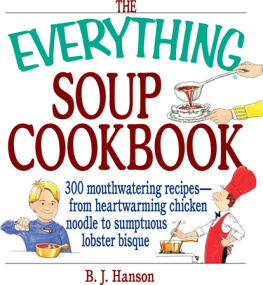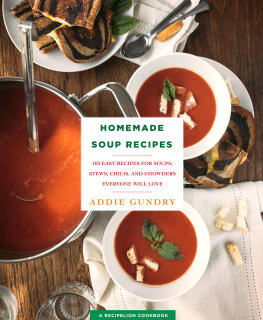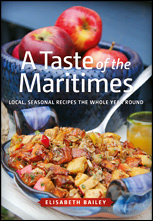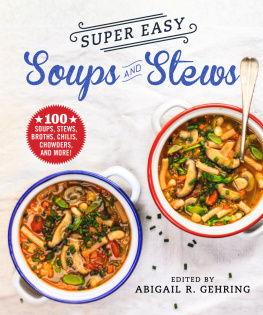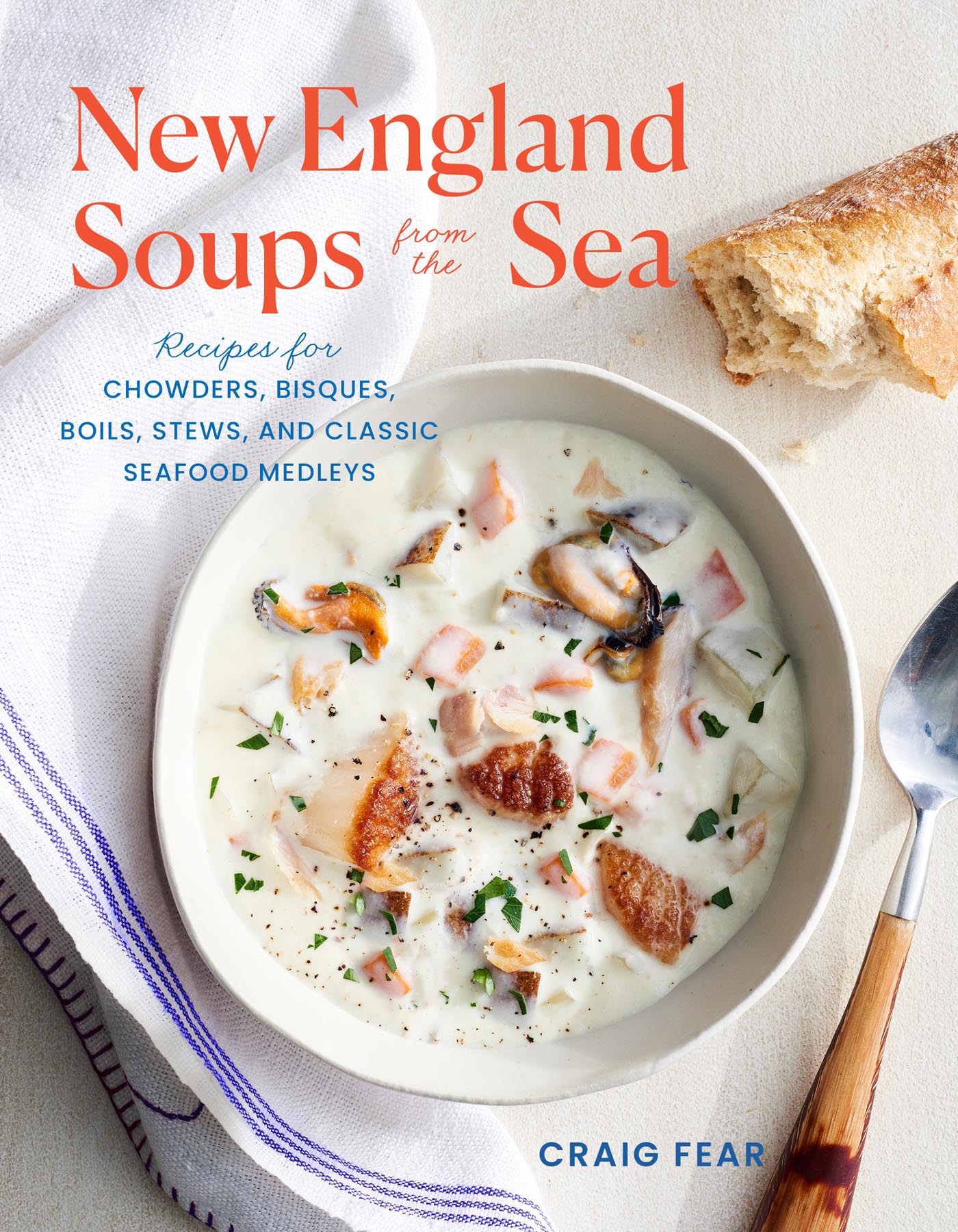Contents
Guide
Page List

New England
Soups from the Sea
Recipes for
CHOWDERS, BISQUES, BOILS, STEWS,
AND CLASSIC SEAFOOD MEDLEYS
CRAIG FEAR

For my uncle Bill Papp (19482019), whose delicious homemade clam chowder simmered in my subconscious for years, and was part of my inspiration to write this book.
Contents
If you are going to follow links, please bookmark your page before linking.

Clam chowder and lobster bisque. Ive eaten at countless New England area restaurants in my 45 years on this earth, and I dont recall a time when these two were not the predominant choices of seafood soups. Even native New Englanders might be unable to name another type of seafood soup.
Not that theres anything wrong with clam chowder and lobster bisque! When made with fresh, real ingredients, they are two of the most delicious soups on the planet. Who doesnt love New Englands most iconic meal: clam chowder, made from juicy local New England hard-shell clams, smoky bacon, onions, and cream? Who doesnt love a rich, sweet, and succulent bowl of lobster bisque? I know no one.
However, there was a time you could find a much greater diversity of seafood soups. You could also find these soups not just in restaurants but on the stovetops in New England home kitchens.
Prior to the middle of the 20th century, cookbooks showcase a time when Americans living on the East Coast embraced the bounty of the sea in all its forms and everything was fair game for the soup pot. The Soup Book by Chef Louis De Gouy, published in 1949, contains one hundred different chowder recipes, using dozens of different fish and shellfish species. Only six of the recipes use clams. The Soup Books bisque chapter contains 34 different recipes. Only three of those use lobster. The Long Island Seafood Cookbook, published in 1939 by J. George Frederick, has numerous recipes for soups, chowders, and stews, very few of which are seen anymore. Some of those recipes include mussel chowder, oyster bisque, watercress clam soup, flounder stew, and many varieties of simple broth-based soups.
For generations, those living near the sea, those who depended on it, knew how to prepare seafood in myriad ways, especially in the form of simple, thrifty soups. Before World War II, fish chowder was as common as clam chowder. Oyster stew, a super simple soup made of oysters, onions, and milk, was widely popular up and down the East Coast. You might also have found brothy soups made without any milk or cream. The highly concentrated liquors (the briny liquid held inside the shells) of shellfish, especially clams, make incredible broths when steamed in water. Similarly, the rich juices of crustaceans (like lobsters) and the wonderful ocean-fresh flavors of fish make beautiful stocks when simmered with vegetables, wine, and herbs. They can be used as a base in countless economical soup recipes. You rarely see broth-based seafood soups anymore, and yet they are some of the most delicious soups Ive ever tasted.
Sadly, in the decades after World War II, many societal changes removed fresh seafood from our kitchens. The increasingly powerful food industry replaced our culinary traditions with chemically laden processed foods. Quick and convenient became Americas new food culture. Fish was packaged into frozen fish sticks, fast-food sandwiches, and, of course, the staple of both kids lunch boxes and the 9 to 5 workforcecanned tuna fish. Seafood soups were now more likely to be consumed from a can than as a home-cooked meal. Not surprisingly, the wonderful flavors, aromas, and textures of fresh seafood were quickly lost. Even worse, they took on a rancid, overly fishy character. This is because, in canning, fish is cooked to very high temperatures, which causes it to lose all its color and flavor. Its why you need gobs of mayonnaise to make canned tuna fish palatable, why canned clams are tough and rubbery, and why canned seafood stocks and broths have lost their fresh ocean essence. These are just a few examples.
As a result, in the decades following World War II, many Americans grew up with a distaste for seafood that they carried into adulthood. Millions more, including even those who lived near the sea, lost the passed-down, traditional knowledge within families for how to cook and prepare seafood, including, of course, soups. Canned soup companies, diners, and fast-food and chain restaurants responded with highly processed seafood soups that had less pronounced seafood flavors. The creamy richness of clam chowder and lobster bisque fit the bill perfectly and were easy sellers for food establishments both in and beyond New England. The heretofore diversity of New England area seafood soups, like many regional traditional foods, slowly ebbed away and became a thing of the past.
But theres good news.
Around the turn of the 21st century, Americans, on a large scale, started demanding better-quality food. Decades of consuming processed foods left us with a long list of increasingly common and easily preventable diet-related illnesses such as heart disease and type 2 diabetes. The locavore movement, that is, the emphasis on fresh, high-quality, organic, locally grown food, which has a lower environmental impact and greater benefit to local economies than processed food, has created a resurgence in farmers markets and regional culinary traditions.
Soups have been a huge part of this! In particular, theres been a revival of interest in homemade bone broths and stocks the way our grandmothers and great grandmothers used to make them, which was from pasture-fed and humanely raised animals. Leftover chicken carcasses, which might include the collagen-rich feet, head, wings, and backs would go in the stockpot along with onions, carrots, and celery, and the ingredients would all simmer for hours to both develop flavor and allow the beneficial nutrients to leach out. Similar stocks and broths were made using beef, pork, and wild game. We also learned in recent years that these infusions have powerful health benefits. And of course, stocks and broths serve as a foundation for innumerable soup recipes.
The rebirth in making traditional stocks, broths, and soups has mostly remained in the realm of agricultural-based foods. Interest in seafood still lags way behind because, lets face it, Americans comfort level with cooking and preparing it is tepid at best. Seafood stocks and broths are rarely, if ever, made at home anymore. And yet, they are just as nutrient-dense, just as healthy, and contrary to popular belief, can be a lot cheaper and simpler to make than chicken and beef stock. Who knew?! And when made in time-honored ways, they acquire an exquisite, delicate essence of the sea that elevates and enhances countless seafood soup recipes. New England, with its rich seafaring history and culinary traditions, can teach us much in this arena. There is so much to rediscover beyond clam chowder and lobster bisque. Theres also unlimited potential to create new recipes too!
That said, theres more to this book than just soup recipes. As you probably know, our oceans are in crisis, and our seafood-buying choices have a powerful impact on the health of our oceans. Fishermen and fisherwomen who fish the right wayethically, legally, sustainably, and with concern for their impact on our oceansare desperately asking us as consumers to do more to support them. And thats what is all about.


